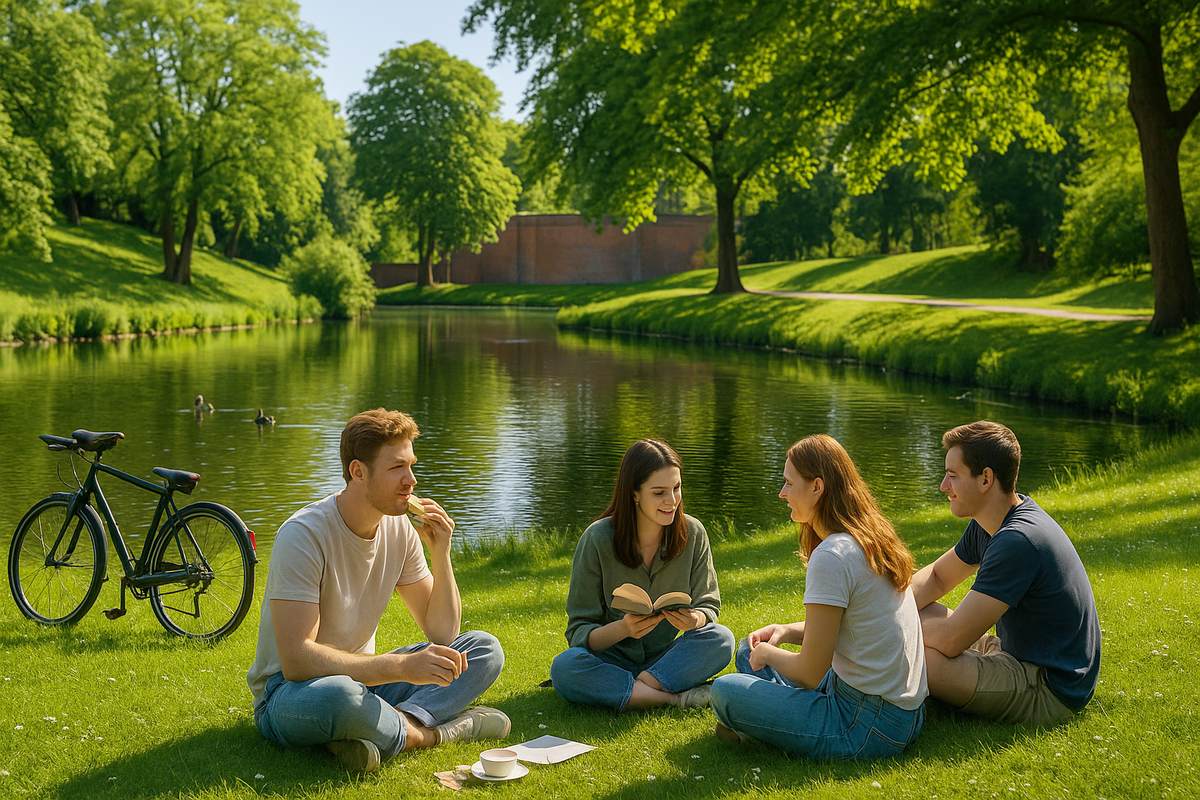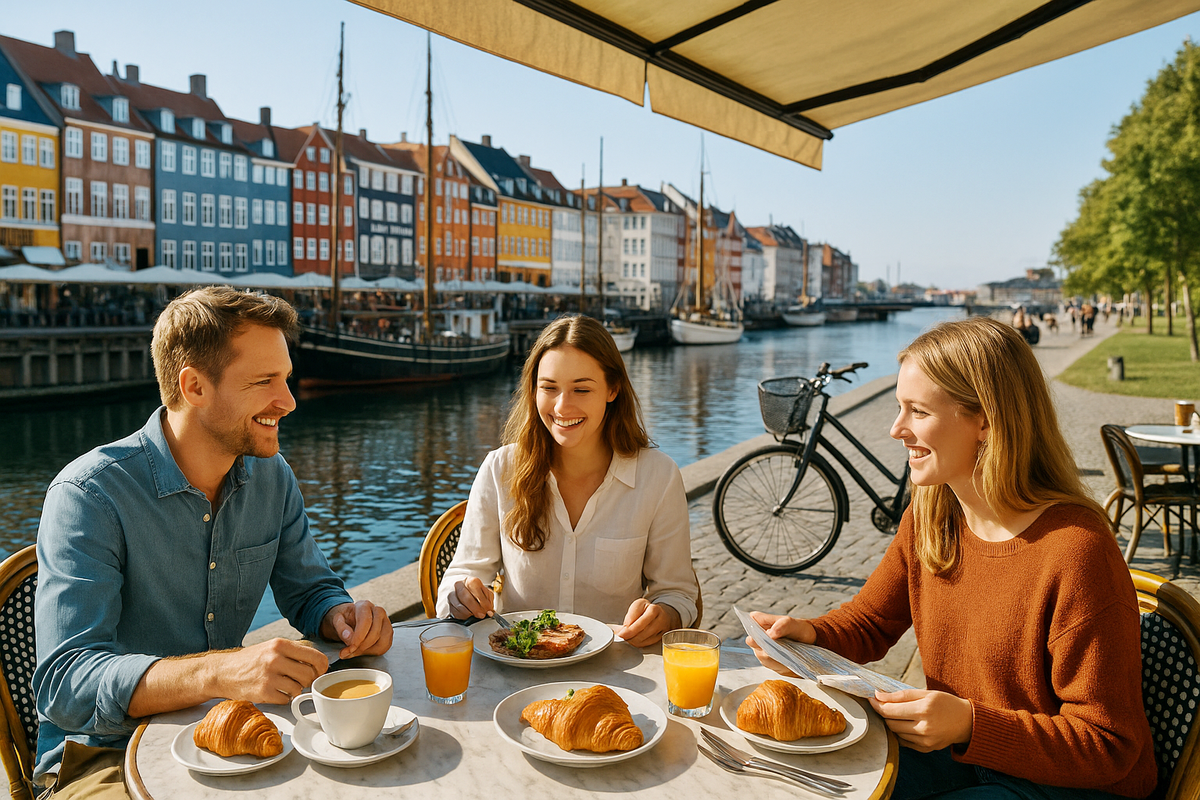🌍 Long day vs short day: June vs December — how it changes your trip
In Denmark, the difference between June and December is not just ‘slightly lighter/slightly darker’. In summer, around the solstice, daylight hours in Copenhagen last about 17.5 hours: the sun rises at around 4:30 and sets at around 22:00, plus long twilight hours.
In winter, around 21 December, the picture is reversed: sunrise is around 8:40 a.m., sunset is around 3:40 p.m., meaning there are just over 7 hours of daylight.
The same ‘2-3 days in Copenhagen’ programme in June and December feels like two different trips:
- in summer, tourists write that ‘we walked until 11 p.m., and the sky was still lit up’ and the city did not let them go;
- in winter — ‘at 4 p.m. it's almost night, we were saved by the lights, cafes and Tivoli.’
This article is not about temperature and rain, but specifically about daylight hours: how many hours you actually have for streets, photos, walks — and what to do with them in June and December.
⏱ June vs December in numbers: how much light do you have in reserve

☀️ June (around the 21st)
- Sunrise: ~04:25–04:30
- Sunset: ~21:55–22:00
- Daylight hours: 17–17.5 hours
Add to that the long ‘white’ twilight: even closer to midnight, the sky is often brighter than a classic night. Guides to summer in Copenhagen separately highlight bright summer nights, when city dwellers sit in parks and by the harbour until late in the evening.
🌙 December (around the 21st)
- Sunrise: ~08:35–08:40
- Sunset: ~15:35–15:40
- Daylight hours: around 7 hours
Plus long, dark twilight: the actual ‘window for walks and photos without a tripod’ is from around 10:00 to 15:00, the rest of the time is either dark or ‘grey twilight’.
🔧 How the length of the day changes the route

🌞 A typical day in June
An example of a ‘working’ day with long daylight hours:
- 08:00–09:00 — breakfast.
- 09:00–14:00 — city centre, Nyhavn, one major attraction (palace, tower, museum).
- 14:00–17:00 — museums / indoor activities / shopping.
- 17:00–22:00 — ‘second day’: canals, parks, neighbourhoods, harbour baths, dinner on the terrace, sunset and post-sunset.
In essence, a June day is ‘one and a half days in one.’ It's easy to squeeze everything in: the historic centre, the neighbourhood walking area, and the evening water/canals. But that's exactly why tourists often complain that they overestimated their strength: there's light, but their legs are gone.
🕯 A typical day in December
An example of a day with short daylight hours:
- 09:00–10:00 — late breakfast (the street is just ‘waking up’).
- 10:00–14:00 — outdoor activities: the centre, Nyhavn, Christmas markets, a few canals.
- 14:00–17:00 — museums, aquarium, indoor entertainment, cafes.
- After 17:00 — focus on lights and hygge: Tivoli, Christmas markets, bars, restaurants, pastry shops, wine and coffee + book formats.
In December, the light corridor is short and expensive:
- walks, photos, viewpoints — strictly from 10:00 to 14:00;
- everything that is ‘under the roof’ — it is better to postpone until dark.
A classic beginner's mistake: sit for an hour and a half in a café in the middle of the only bright window, and then try to finish photographing the city in the semi-darkness.
🚴 June: how to make the most of the long days

June offers you maximum flexibility: comfortable temperatures, long days, and an active city life.
🎯 What's especially good in June
- Long promenades and cycle routes — along the harbour and parks.
- Canals at any time of day, but especially in the evening when the sky is still light.
- Harbour baths and beaches: even when the water is cool, the atmosphere is as summery as can be.
- Parks, picnics, street festivals, music events and design weeks — the city literally ‘comes outside’.
🗓 Example of a 2-day June itinerary
Day 1
- Morning: city centre, town hall, Strøget, observation deck.
- Day: Christiansborg / Rosenborg.
- Evening: Nyhavn + canal cruise + dinner by the water.
Day 2
- Morning and afternoon: one district (Nørrebro/Vesterbro) + walk along the harbour or bike ride.
- Evening: Tivoli or live dinner with a walk through the illuminated city centre.
Due to the long days, it feels like two ‘busy but manageable’ days.
🗓 Example of a 3-day trip in June
Day 1 — classic city centre + canals.
Day 2 — museums (Glyptotek, Nationalmuseet, SMK) + evening in Tivoli or by the harbour.
Day 3 — either a day trip (e.g. Louisiana Museum of Modern Art with a view of the sea) or a deep dive into the neighbourhoods and city beaches.
⚠️ Risks of a long day
- You want to ‘pack in’ both the morning and the evening → overheating and burnout on the second day.
- Due to the late light, many people write that it is difficult to fall asleep: even thick curtains in the hotel do not help.
💡 Practical life hack:
- plan a 1-2 hour break during the day (hotel, spa, just a quiet café);
- take a sleep mask — especially if you are sensitive to light;
- do not schedule strenuous activities (long tours, alcohol) for late in the evening, even if it is ‘still light and seemingly early’.
🎄 December: how to adapt to 2–3 days of short daylight hours

Yes, December in Copenhagen is ‘wet, cold and dark’, as the locals honestly write, but they immediately add: ‘but the lights and cosiness make up for it’.
🎯 What's good about December
- Christmas markets and decorated streets, especially Nyhavn, Kongens Nytorv, Højbro Plads and Christiania.
- Tivoli in Christmas mode: ice rink, hundreds of thousands of lights, a separate Christmas season with extended opening hours.
- Hygge atmosphere: candles, mulled wine, cosy cafés and wine bars.
🗓 Example of a 2-day December itinerary
Day 1
- 10:00–14:00 — city centre, Nyhavn, a little shopping and photos in the daylight.
- 14:00–17:00 — 1–2 museums or the aquarium.
- Evening — Tivoli: ice rink, rides, lights, mulled wine.
Day 2
- 10:00–14:00 — Christmas markets, a walk through the historic streets, possibly a short canal cruise if the weather is good.
- 14:00–17:00 — another museum / design centre / large indoor market (shopping and food halls).
- Evening — restaurants, bars, coffee shops, the ‘cosy’ part of the programme.
🗓 Example of a 3-day trip in December
Day 1 — city centre + Tivoli.
Day 2 — heavy indoor day with museums, aquarium, markets.
Day 3 — either another museum/gastronomy day or a short trip (for example, to a suburban castle or coastal town — weather permitting).
💡 Practical tips for December:
- anything that is ‘outdoors’ and emotionally important (canals, colourful streets, photos) should be scheduled strictly in the middle of the day;
- always have a plan B — a set of indoor places in case of wind/rain;
- allow more time for cafés and restaurants: in winter, this is the core of the programme, not an ‘addition’.
💶 Prices and budget: June vs December

💸 June — high season
Summer reviews of Copenhagen agree:
- June is a time of long days, mild weather and high hotel occupancy,
- with prices often marked as ‘High / expensive’ compared to spring and autumn.
Pros: maximum outdoor activities for the same money (parks, free areas by the water, street life).
Cons: more expensive nights in central areas; airfares and trains may also ‘grow’ by the start of the summer season.
❄️ December — winter and Christmas peak
The picture is more complicated in December:
- early December can be relatively moderate in terms of prices;
- the weeks before Christmas and Christmas week itself are the peak of demand: short trips to see the lights and markets, increased occupancy and rates.
At the same time, part of the budget shifts:
- more spending on Tivoli, markets, hot drinks, indoor entertainment;
- from the point of view of ‘city cards,’ December is often profitable: short days and unpredictable weather motivate people to make the most of museums and indoor attractions for a fixed amount.
📆 How the length of the day affects the optimal number of days
‘2–3 days in June’
- With 2 days, you can do a lot thanks to the long days: the city centre, canals, a couple of museums, and at least one area outside the ‘postcard’ zone.
- 3 days allow you to add either a day trip or a relaxing day by the water and in the parks — without feeling rushed.
Risk: the desire to ‘make the most of the daylight’ → no rest, and by the end of the second/third night you are exhausted.
‘2–3 (4) days in December’
- 2 days in December is an option, but with a high risk: if one day is very windy/rainy, you will see the city mainly from inside cafes and museums.
- 3 days is more comfortable: there is a chance for one truly successful sunny day + two evenings with lights.
- 4 days make sense if you want a rich Christmas programme and a reserve for weather/fatigue.
⚠️ Common mistakes and useful life hacks
Mistakes
- 📅 Thinking that a ‘3-day’ itinerary can simply be copied from June to December without adjusting for the length of the day.
- 🌞 In June — scheduling every hour until 11 p.m. without allowing for rest or ‘doing nothing’ .
- 🌚 In December — schedule walks and photo shoots for the evening, and use the daylight hours for shopping and cafés.
- 🎒 Not taking the basic kit:
- in June — a sleep mask and the option to darken the room;
- in December — layered clothing, waterproof shoes and a plan B for the weather.
Life hacks
- ☀️ In June, book observation decks, rooftops, and panoramas for the ‘golden hour’, when the city is especially photogenic.
- 🕯 In December, check the opening hours of museums, Tivoli, and fairs in advance to combine light and lights: some attractions are open until late in the evening, but you only have daylight during the day.
- 🧠 June: plan a midday break if you are planning an active evening.
- ☕ December: think of cafés, markets and bars as the centre of your itinerary, not just a ‘snack between points’.
✅ Conclusion: is your month June or December?
Let's formulate this as a quick checklist.
If you are into light, water and movement, your month is June ☀️
- You enjoy long walks, cycling, embankments and parks.
- Photos and ‘pictures’ in natural light are important to you.
- You are ready for active days and a flexible schedule.
If you are into lights, cosiness and the Christmas atmosphere, your month is December 🎄
- You adore lights, fairs, garlands, cosy cafes and mulled wine.
- You like the idea of short bright days and long cosy evenings.
- You are ready to accept the cold, possible rain/snow, layered clothing and a plan B for the weather.
If you don't like the crowds of summer or the gloom of winter, perhaps your ideal answer is the shoulder months (May, September). But it is precisely the contrast between June and December that helps you understand what is more important to you in Denmark — long days and outdoor life or short days and hygge evenings.
FAQ
💡 If you value long daylight hours, walks, water and street life, June is the logical choice. If you want lights, Christmas, Tivoli and hygge evenings in cafés, December will give you a more atmospheric experience, but with shorter daylight hours.
💡 Around 21 June, there are approximately 17 hours of daylight, while around 21 December, there are only about 7 hours. In summer, you have ‘one and a half days in one’, while in winter, there is a narrow window from 10:00 to 15:00 for outdoor activities and photos.
💡 In June, even 2-3 days can be filled very tightly due to the long day. In December, 2 days often feel short, especially in bad weather, so it is more comfortable to plan 3-4 days to have a reserve for light and evenings.
💡 If you adjust your itinerary to the short days — walking and taking photos during the day and focusing on the lights, Tivoli, markets and cafes in the evening — December will not be dreary and dark, but rather a very atmospheric ‘hygge format’ . It's a mistake to try to live according to a summer scenario.
💡 In June, it's important to plan breaks during the day and take a sleep mask with you — long days can easily lead to overload. In December, it's crucial to think ahead about layered clothing, have a plan B for the weather, and use the daylight hours for the streets and the darkness for the lights, museums and restaurants.





0 comments
Log in to leave a comment